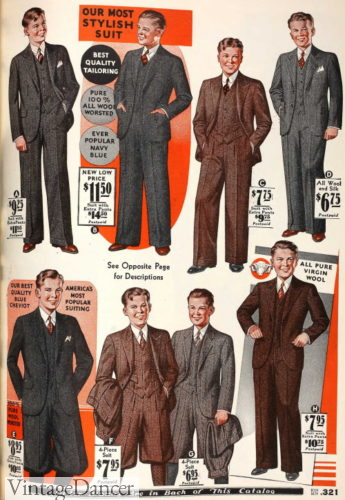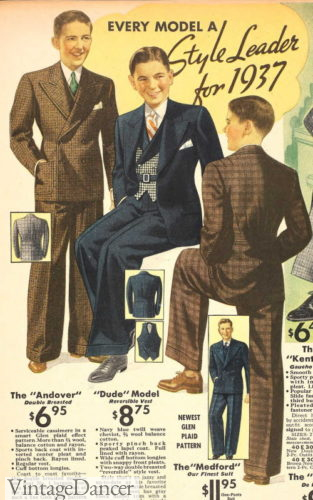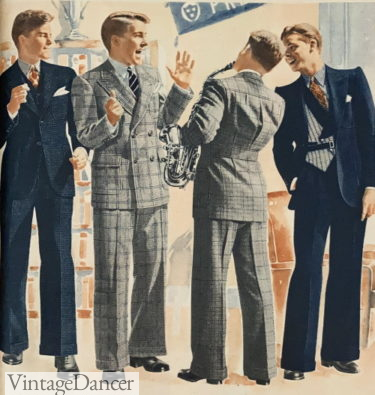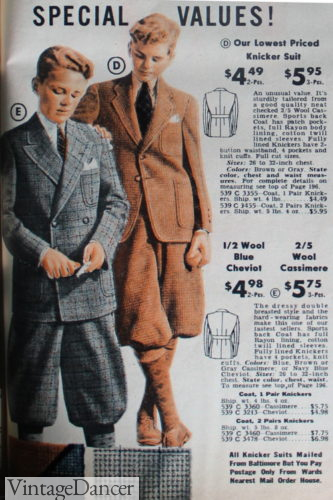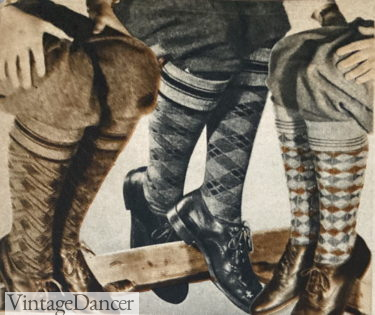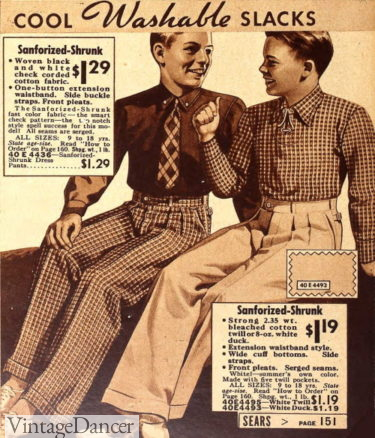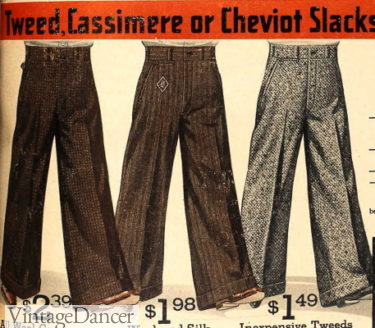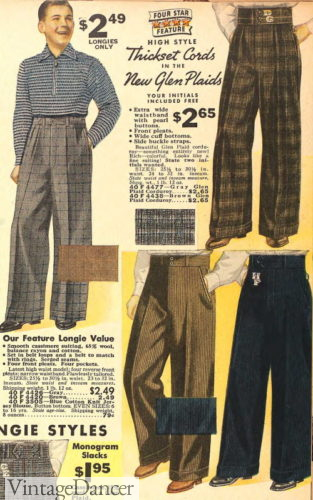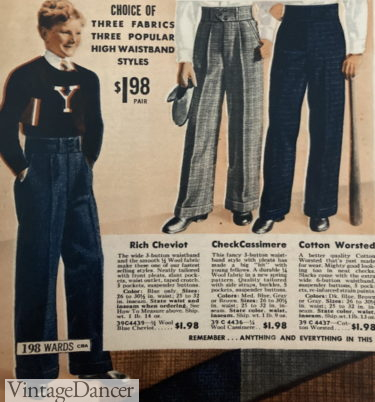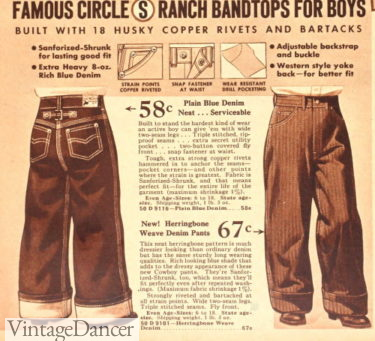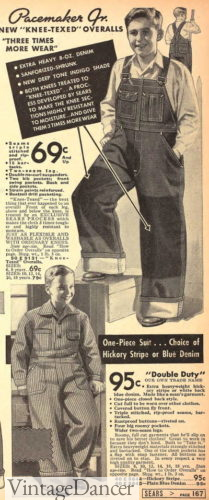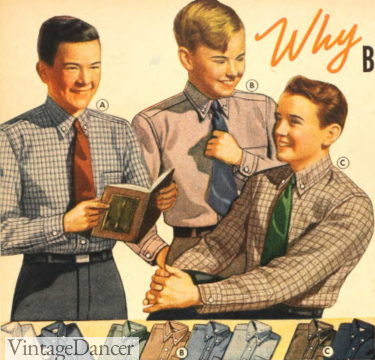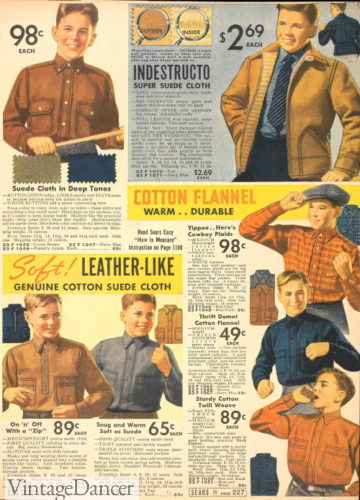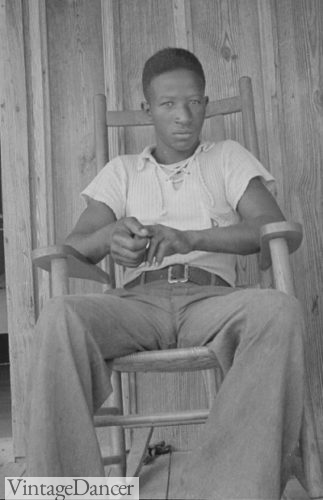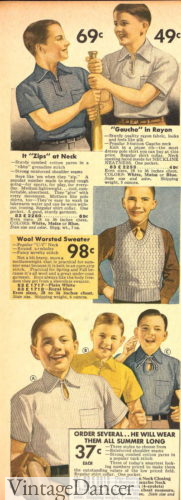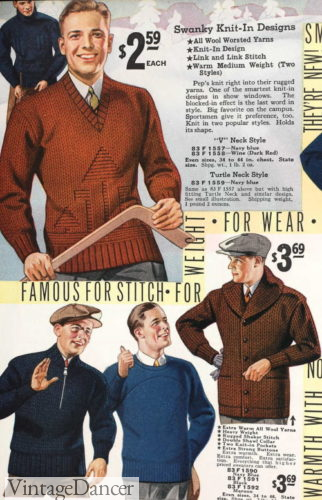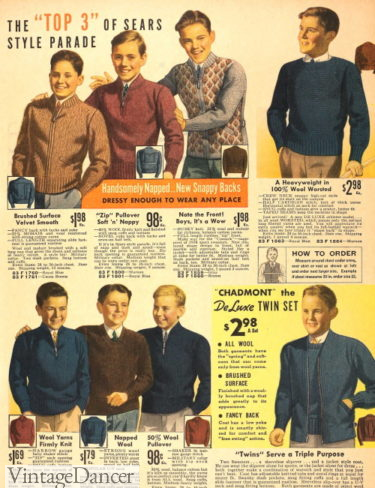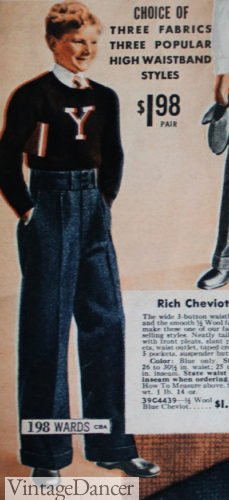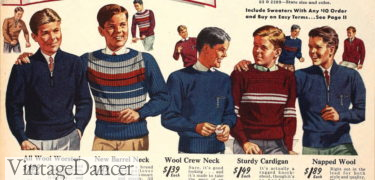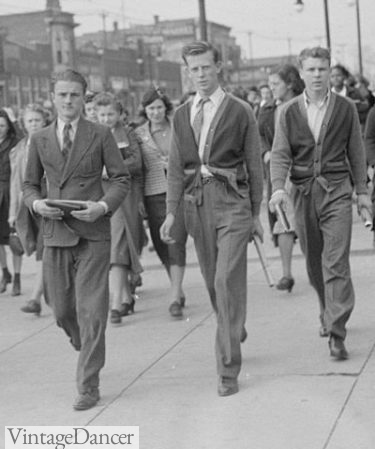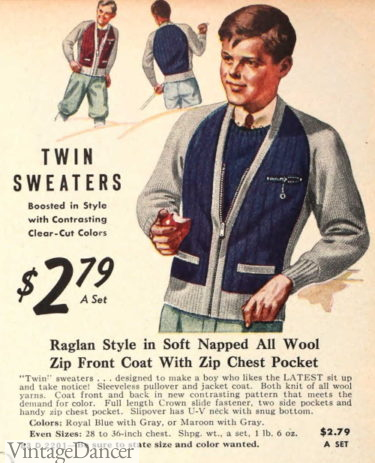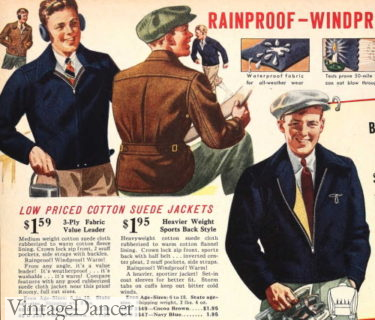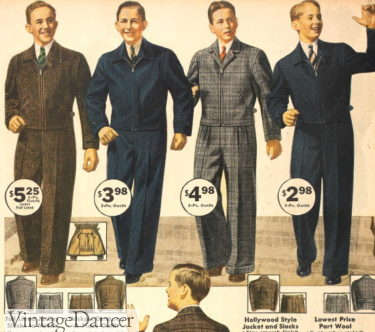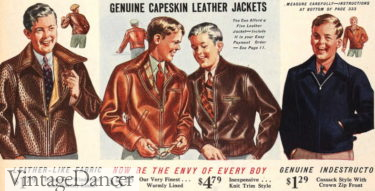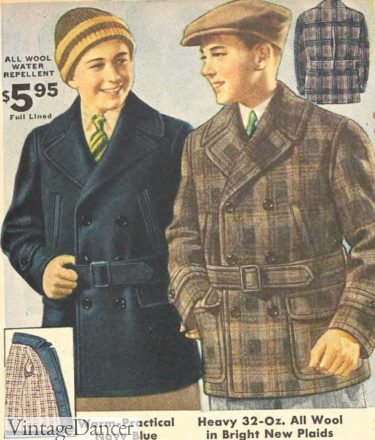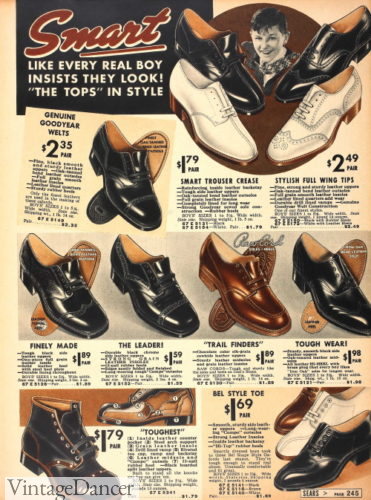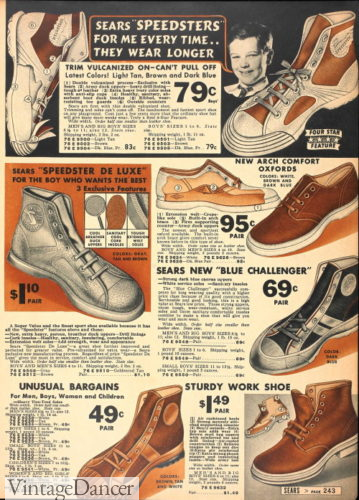Teenage boys in the 1930s dressed very different from today’s casual youth. At high school, dress codes require teen boys to wear suits and ties. At home, they could wear more casual clothes such as polo shirts. Following the same styles as older men did, the teenager softened up the formal look with sweaters and vests, combining the best of casual and dressy fashions.
School Clothes: Suits
School dress codes for most city schools required teen boys to wear a suit: dress shirt, tie, suit trousers, suit jacket, and dress shoes. The suit jacket may not have been worn inside or taken to school at all in fair weather.
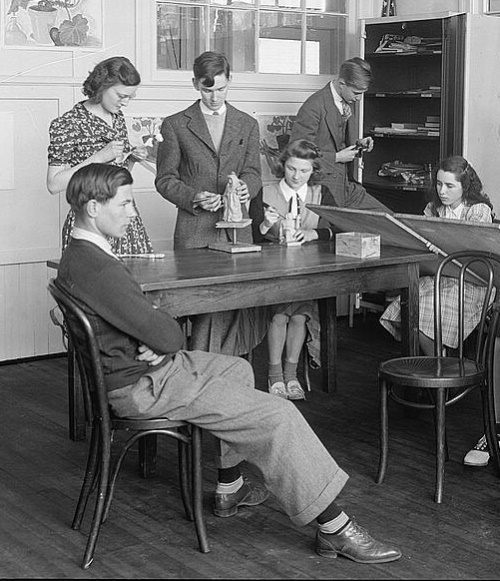
1936 Montgomery High School Students
Teen’s suits, like their father’s, were shades of brown, blue, and grey in single and double breasted jackets with patterns of stripes, checks, and plaid. A matching vest was often sold with suits, yet many boys chose to wear a knit vest or sweater instead of the vest, saving it for dressy occasions and church on Sundays.
For special occasions, the “yacht” look of white pants and blue blazer may have been worn to graduation ceremonies, vacations, weddings, and prom.
- 1931 Suits
- 1937 Suits with Contrasting Vests
- 1938 Summer Suits
- 1938 Graduation Suit of White Pants and Blue Blazer
Knicker Pants
Boys did not wear long trousers until their teen years, around age 14. Until then, they wore knickers. This was a decision made by parents (to the student’s horror, if not allowed by high school). Some teens did wear knickers throughout high school if finances were limited. They were also worn for certain outdoor sports and activities, such as golf and hiking.
Knicker pants were baggy pants cropped below the knee with a ribbed cuff. Tall patterned socks were worn up and over the knee cuff.
- 1938 Knicker Suits
- 1938 Patterned Tall Socks to be Worn with Knickers
Similar looking short pants, called breeches, were worn for riding horses, hiking, hunting, and certain after-school jobs. These laced up over the calf and were worn with tall boots.
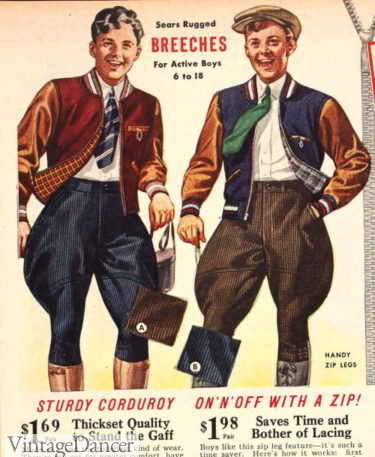
1939 Boys’ Breeches
Long Trousers
Once the wearing of long trousers was allowed, teen boys bought wide leg, high waisted trousers in durable and dressy materials. Durable corduroy and heavy wool were the longest wearing, while lighter wool suiting trousers matched suit jackets or were sold separately in even more colors and bigger patterns.
Teens set the trend for wide waistbands in the 1930s. Some had double rows of buttons, some had tab-over button straps. and some resembled the tops of men’s NAVY sailor pants. Flat fronts and pleated trousers with turn-off cuffs were in style.
- 1937 Boys’ Pants
- 1935 Wool Trousers
- 1937 Teen Boys’ Pants
- 1938 Teen Trousers
Jeans & Overalls
In the country, school dress codes were relaxed to allowed boys to wear “workwear” clothing to school. This could mean denim overalls, coveralls, or jeans paired with heavy flannel or chambray denim shirts. These may have been banned in city schools, but on the weekends, teens often chose to wear workwear/casual clothing instead of suits.
My father in law taught high school in the 1930s in L.A., California. He said when the farmer’s kids escaping the dust bowl arrived at school, they were dressed in ripped, torn, dirty overalls and bare feet. The school had no choice but to allow them to wear these clothes until their families could afford better.
- 1939 Denim Jeans
- 1937 Overalls and Coveralls
Around 1930 there was a trend that started among the singing copyboys of Hollywood. The “Whoopee” pants were flared leg striped denim jeans with a red elastic panel inset at the leg and front pockets and often red top stitching at the seams. They look a lot like 1970s bell bottoms.
They were colorful and loud and oh so fun for boys and teens. The word Whoopee in this context is slang for “go out and have a good time” not “make out with a hug and kiss” which was also used in the 1930s but not applied to clothing.
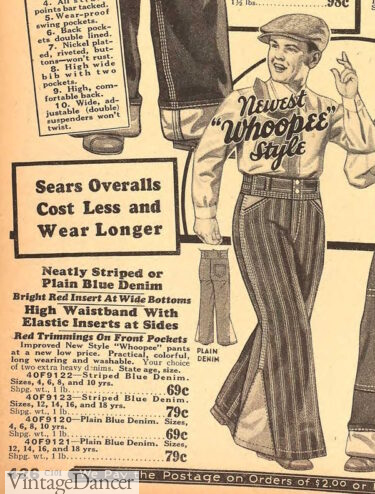
The Whoopee style name was also applied to any straight wide leg pants with a high and wide waistband. Fabric could be striped wool with silk or rayon threads. They also came by the name “Hollywood waistband” which is what teens and most grown men called them.
Boys Shirts
Dress shirts and ties were worn with teens’ suits. Dress shirts were colorful blues, green, tan, brown, and white with check patterns or solid coloring. Read more about men’s shirts and ties.
Casual or work shirts were made of flannel, heavy cotton, chambray denim, or suede finished cotton. They had two chest pockets.
- 1937 Boys’ Dress Shirts
- 1937 Boys’ Work/Casual Shirts
In hot weather, boys would roll up the sleeves of their shirts (if allowed at school). At the Texas school below, they were allowed to remove ties too.
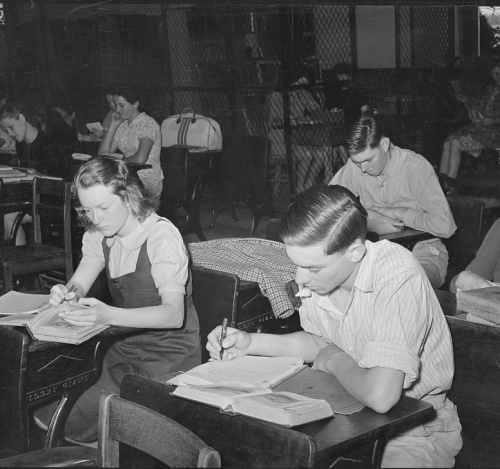
1939 Study Class in Library. High School, San Augustine, TX
Outside of school, sport clothes (what we call casual clothes) were what teen boys preferred to wear on weekends. Short sleeve knit Polo shirts were the latest fad – one of the first short sleeved shirts for men! There were also ringer T-shirts in horizontal stripes. Read more about 1930s dress and casual shirts here.
- 1936 Polo Shirt, Trousers, and Belt – Casual Style
- 1937 Boys’ Polo Shirts
Sweaters
Teen boys loved knitwear. It was far more comfortable and casual than stiff suit vests and jackets. Teens often wore sweaters, cardigans, and zip-up knit jackets over shirts and ties.
Sweater trends included the “letter sweater,” featuring a school initial and the two tone cardigan sweater in the late 1930s. More about 1930s sweaters can be found here.
- 1934 Sweaters and Cardigans
- 1937 Sweaters and Knit Jackets
- 1938 Letter Sweater
- 1939 Sweaters
- 1938 High School Students in Omaha, Nebraska. Two Boys Wearing Cardigan Sweaters.
- 1939 The “Twin Set” Sweater
Jackets
The newest style of outerwear for men and boys was the Cossack jacket. It became so popular that two piece suits were being sold with matching trousers and a Cossack jacket. There were also short leather jackets (bomber jackets) and heavy plaid mackinaw jackets for winter.
- 1939 Cossack Jackets
- 1937 Cossack Jackets and Trousers
- 1939 Leather Jackets
- 1937 Mackinaw Jackets
Whenever possible, boys wore short jackets instead of long coats, but most boys had at least one to wear. More about 1930s coats and jackets.
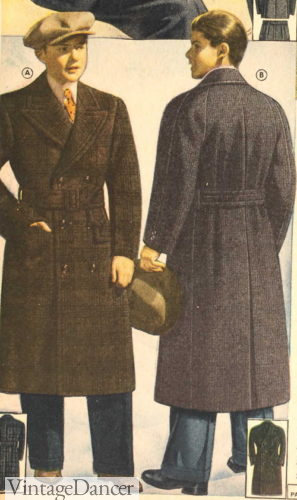
1937 Long Wool Overcoats for Teens
Shoes & Socks
Men and boys wore the same shoes everyday. Oxford shoes with a cap toe, wingtip, moccasin toe, or other trending design in black, brown, or white were ideal for suits. Lace-up boots were also worn especially with the casual/ workwear/ weekend clothing.
For playing sports, on weekends, and sometimes as everyday school shoes, teen boys put on high top canvas sneakers. Converse was an available brand and one of many other cheaper brands in similar styles and two tone colors. Low profile canvas shoes such as Keds were also worn for tennis or beach going.
Learn more about 1930s men’s shoes.
- 1937 Oxford Shoes
- 1937 Sport Shoes
Teen boys’ socks were colorful stripes and patterns like these:
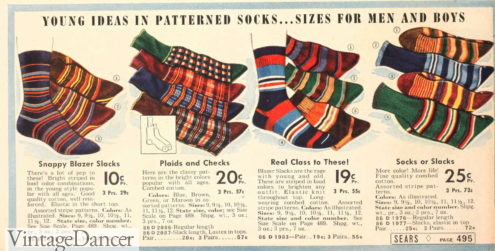
1930s Teen and Boys’ Socks
Hats
Most teen boys did not wear hats every day. They sometimes wore golf caps with casual or sporty outfits. The cap was considered too “boyish” for older teens to wear with suits. For dressy occasions and church, boys may have worn a felt fedora hat, like that of their fathers.
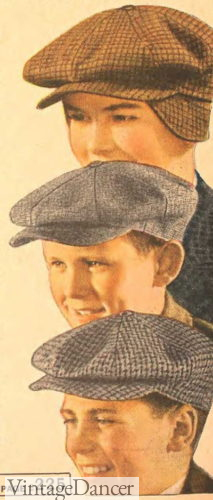
1937 Boys’ Caps
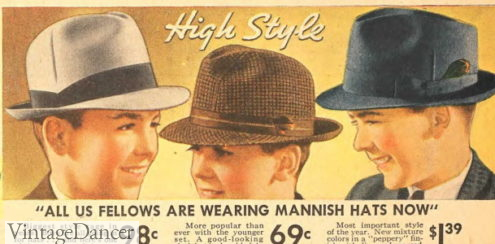
1937 Boys with Felt Hats
Underwear
Underneath clothing, teen boys preferred a sleeveless undershirt and pair of boxer shorts. These were more manly than the white cotton briefs or union suits that they wore as boys. Long union suits (long johns) made of wool were still worn in winter. More about underwear and sleepwear.
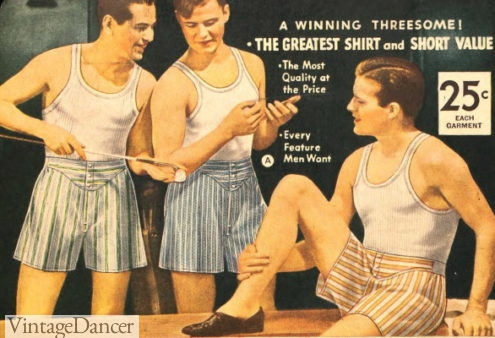
1935 Undershirts and Boxer Shorts
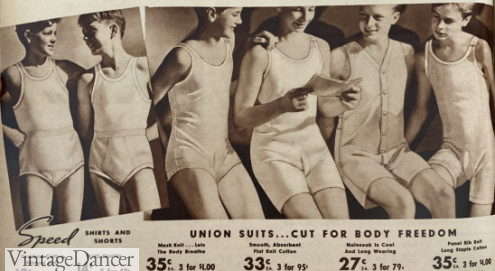
1938 Cotton Briefs or Union Suits
Teen’s Wardrobe Plan
Family budgets were tight in the 1930s. Teen boys has a limited amount of budget to spend on new clothing every year. Because of how quickly they outgrew clothing, their budgets could be higher than adults and even young children. A new suit was purchased every year (or purchased second hand) as well extra trousers, shirts and underwear. Some clothing such as robes, coats, and ties would have been purchased every 2-3 years.
The following plan is what a typical teen buy may have purchased in one year:
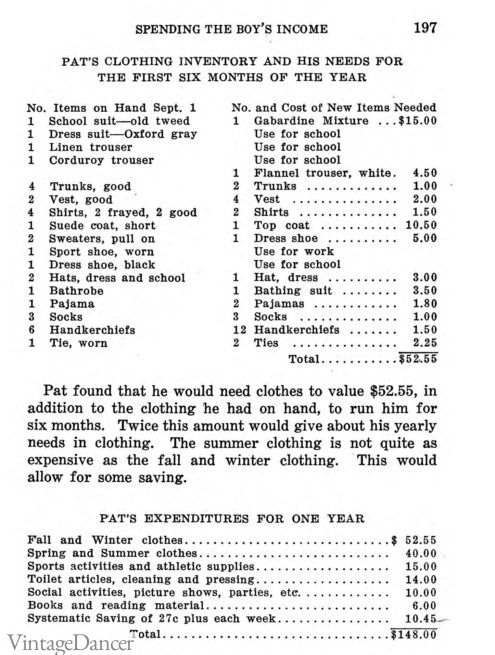
1935 teen boys clothing plan
In addition to the above, gymnasium outfits and team sport clothes may have been purchased for use at school. Special formalwear could have been required in the city to attend dances and parties. Some budget was set aside for shoe repairs and clothing alterations as well.
More Teen Fashion History
- 1910 Teen Boys Clothing
- 1920s Teenagers’ Fashion
- 1940s Teenage Fashion for Boys
- 1950s Teen Boys Clothing
Debbie Sessions has been teaching fashion history and helping people dress for vintage themed events since 2009. She has turned a hobby into VintageDancer.com with hundreds of well researched articles and hand picked links to vintage inspired clothing online. She aims to make dressing accurately (or not) an affordable option for all. Oh, and she dances too.
